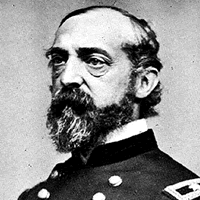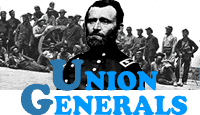
|
|
VITAL STATISTICS
|
BORN: 1815 in Cádiz, Spain.
DIED: 1872 in Philadelphia, PA.
CAMPAIGNS: Washington DC, Mechanicsville, Gaines' Mill,
White Oak Swamp, Second Bull Run, Antietam, Fredericksburg
Chancellorsville, Gettysburg, Mine Run.
HIGHEST RANK ACHIEVED: Major General
|
|
BIOGRAPHY
|
| George Gordon Meade was born on December 31, 1815, in Cádiz, Spain, while his father was working as a naval agent for the US. His father, Richard Worsam Meade, was working as a naval agent for the US, and the family lived well overseas. When Richard Meade died in Washington, D.C., his family was not able to collect the money which the government owed them. The resulting financial difficulties required young George Meade to withdraw from school in Philadelphia and attend a school in Washington, D.C. Salmon P. Chase, later a Union politician, led the school. Meade was appointed to the US Military Academy at West Point, and graduated in 1831. He took a short leave to take part in the survey for Long Island Railroad. Returning to the military, he participated in the Seminole War. He became ill with a fever, then was placed on duty in Massachusetts. In 1836, he resigned from the army to work as an engineer on the Alabama, Florida & Georgia Railroad and the survey work on the Mississippi and the Texas border. He got married, then rejoined the army in May of 1842. Meade continued working on military engineering projects until the Mexican War. He was brevetted a 1st lieutenant for bravery for his service in the Mexican War, and went on to participate in engineering work on coastal lighthouses. He was also in charge of the surveys of the Great Lakes. Appointed a brigadier general of volunteers on August 31, 1861, Meade led one of the three Pennsylvania brigades. He helped build Fort Pennsylvania as part of the defense of Washington, D.C. When his command was transferred in March of 1862, Meade was assigned to the Virginia Peninsula, under Maj. Gen. George B. McClellan. Leading a brigade as a major in the Corps of Topographical Engineers in the Regular Army; Meade took part in the Battles of Mechanicsville and Gaines' Mill. Wounded in the hip and arm at the Battle of White Oak Swamp, he remained in command on the field until he was physically unable to continue. Meade took a leave to recuperate, but returned before he was fully recovered. He fought in the Battles of Bull Run (Second) and South Mountain. At Antietam, he maintained a brave effort until his troops ran out of ammunition. He took over corps command when Maj. Gen. Joseph Hooker was severely wounded. In October and November of 1862, Meade was given divisional leadership, under McClellan, in pursuit of Confederate General Lee. Promoted to major general on November 29, 1862, Meade was given command of the V Corps on December 25, 1862, after the Union had suffered serious losses at Fredericksburg. He later took part in the Battle of Chancellorsville in May of 1863, and was placed in command of the Army of the Potomac. He accepted the position, although he was surprised by the offer. Three days later, he met General Lee's forces at Gettysburg by chance. He fought there, managing his troops well, but lacking the aggression he might have needed to press his advantage. Meade was awarded a Thanks of Congress for his efforts to repel the Army of Northern Virginia. Promoted to brigadier general in the Regular Army as of July 3, 1863, he maintained command through the campaigning along the Rapidan River that autumn. After the Mine Run operation, Lt. Gen. Ulysses S. Grant accompanied the Army of the Potomac; so that Meade remained in command until the surrender at Appomattox, but was somewhat overshadowed by Grant's presence. On August 18, 1864, Meade was promoted to the rank of major general in the Regular Army. After the Civil War ended, Meade was given command of the Military Division of the Atlantic and the Department of the East in Philadelphia. He worked in Atlanta, Georgia to administer Reconstruction policy, trying to maintain an atmosphere of sensitivity and fairness. In 1866, he was made commissioner of Fairmount Park in Philadelphia, and remained in the post until his death, which occurred because of a combination of old war wounds and pneumonia, on November 6, 1872. |
|

